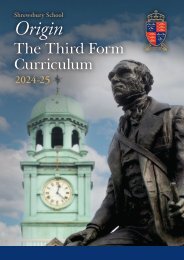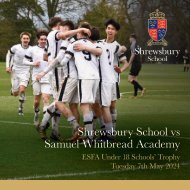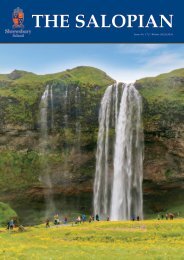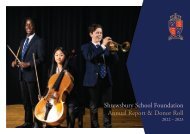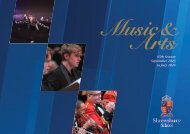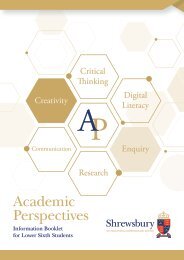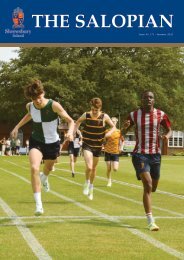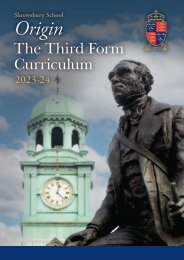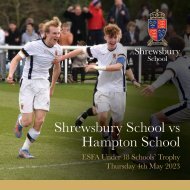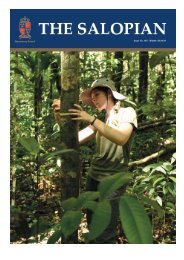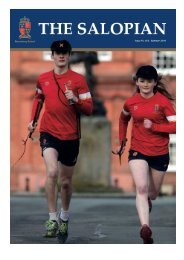The Salopian no. 157 - Winter 2015
Create successful ePaper yourself
Turn your PDF publications into a flip-book with our unique Google optimized e-Paper software.
20 SCHOOL NEWS<br />
different views as well as the unique<br />
flora and fauna which included giant<br />
bromeliads containing endemic golden<br />
frogs and carnivorous plants. <strong>The</strong>re<br />
were <strong>no</strong> safety barriers, <strong>no</strong> shops and<br />
we were the only people there. It<br />
was such a privilege to see the falls as<br />
Charles Barrington Brown might have<br />
seen them when he discovered them<br />
in 1870 – that’s something <strong>no</strong>ne of the<br />
other great waterfalls can offer and an<br />
experience <strong>no</strong>ne of us will forget.<br />
After returning to Georgetown, a tenhour<br />
drive south took the group to<br />
Iwokrama Research Centre where three<br />
days were spent training to gather the<br />
skills to gather data accurately, sleep<br />
safely in the forest in hammocks and<br />
use machetes (or cutlasses as they<br />
are k<strong>no</strong>wn). <strong>The</strong> health and safety<br />
presentation we had on arrival was<br />
pretty sobering given the long list<br />
of incredibly scary things that could<br />
happen to us but ended with cheerful<br />
reassurance from Scot Sveiven, a<br />
specialist on forestry and our superb<br />
expedition leader. An excellent series<br />
of lectures by the resident scientists<br />
enabled us fully to appreciate the<br />
importance of the work we were<br />
doing. <strong>The</strong> Centre was situated in a<br />
clearing surrounded by rainforest on a<br />
broad sweep of the mighty Essequibo<br />
River which was 200m wide even<br />
though we were 200km from the sea.<br />
From the moment of our arrival, we<br />
were surrounded by wildlife with<br />
woodpeckers, macaws, parrots, hawks,<br />
giant cane toads, howler monkeys<br />
and agouti at the forest margins as<br />
well as caiman in the river. Walking<br />
at night revealed a different set of<br />
organisms including a beautiful but<br />
very dangerous fer de lance snake well<br />
camouflaged on a tree trunk.<br />
A further three-hour drive south in<br />
two Bedford four-tonne trucks took<br />
the team to Surama, an Amerindian<br />
village belonging to the Makushi<br />
Tribe which has set up an awardwinning<br />
ecotourism project to bring<br />
income to their remote community.<br />
We spent the following three days<br />
carrying out surveys for mammals,<br />
bats and herpetofauna. <strong>The</strong> mammal<br />
day involved walking along a transect<br />
(a straight line through a habitat)<br />
recording evidence of mammals<br />
including their tracks with jaguar<br />
expert, Matt Hallett. Matt is studying<br />
for his PhD at the University of Florida<br />
and has built up an extensive network<br />
of camera traps to study the behaviour<br />
and distribution of jaguar. He had<br />
unbelievably sharp eyes and his<br />
tracking skills were truly impressive.<br />
Each group spent the after<strong>no</strong>on setting<br />
up camera traps with him, which<br />
revealed the many details which need<br />
to be considered when locating a<br />
trap. <strong>The</strong> work of the bat groups was<br />
<strong>no</strong>cturnal so their morning was spent<br />
hiking up Surama Mountain – a steep<br />
climb in stifling conditions but well<br />
worth it for an amazing view over the<br />
forest and rare sightings of macaws at<br />
eye height. In the evenings mist nets<br />
were opened and checked every hour<br />
Finn McCormack handling a cat-eyed snake<br />
into the small hours and bats caught<br />
were bagged and taken back to camp<br />
for identification, weighing, and wingclipping<br />
with bat expert Stef Bonat.<br />
<strong>The</strong> area has one of the highest levels<br />
of bat biodiversity in the world and<br />
one group was lucky to catch a rare<br />
Hugo Moran counting dung beetles<br />
vampire bat, although it escaped from<br />
the mist net before it could be bagged.<br />
<strong>The</strong> herpetology groups walked along<br />
transects by day and night attempting<br />
to catch any snakes, lizards and frogs<br />
spotted. Peruvian herpetologist, Alfredo<br />
Martin Beraún Rivera did most of the<br />
catching but he let us handle the <strong>no</strong>nve<strong>no</strong>mous<br />
species such as the Amazon<br />
tree boa, blunthead tree snake and<br />
cat-eyed snake. During downtime in<br />
the heat of the day, cool drinks and<br />
comfortable hammocks in the bar of<br />
Surama Ecolodge provided a chance to<br />
rest and rehydrate.<br />
<strong>The</strong> team then walked deeper into the<br />
jungle, spending a further three days<br />
at Carahaa Landing – a jungle camp on<br />
the banks of the Burro Burro River. As<br />
river levels had risen due to the daily<br />
torrential showers, we had to take to<br />
boats to make our way through the<br />
flooded forest. <strong>The</strong> camp had an opensided<br />
wooden structure in which many



